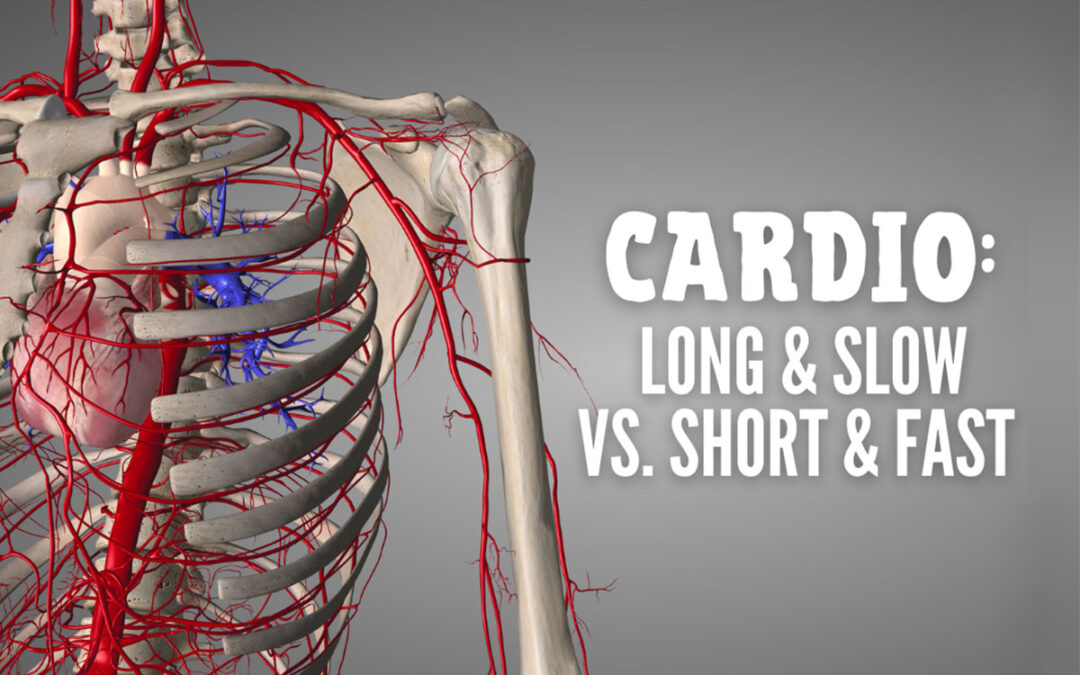You are more likely to die of something heart-related than you are strength or flexibility-related.
Coronary heart disease is killing a quarter of us and that’s a problem. (1)
Cardio falls into two general categories:
- Long, slow at medium intensity
- Short, fast at high intensity
What’s the difference and what should you be doing? Let’s discuss…

Your body’s arteries are like highways. They can be wide, 6-lane highways that accommodate many cars at a time (eccentric hypertrophy) or they can resemble narrower 2-lane highways where cars would have to drive faster in order to transport the same number of vehicles an equal distance (concentric hypertrophy).
The heart’s left ventricular cavity can get stretched out and pass more blood per stroke (eccentric) or it can thicken and strengthen its walls and push blood out faster and harder (concentric).
Eccentric heart training is associated with long, slow, medium cardio. Concentric heart training is associated with the short, fast, intense versions, like sprints, and exercise that isn’t as cardiovascular, like pure strength training. Many studies show that both forms of cardio are great for improving health markers such as increased fat loss, reduced blood pressure, and increased VO2 Max. (2, 3, 4)
There is a catch: the short, fast, intense stuff is… intense. And if you are truly doing it intensely, it is too hard on the system to repeat often in the week. High-intensity forms of cardio usually require greater physical pre-requisites to do safely as well. If that is your only form of cardio, you are more likely to burn out, which is a drop inconsistency and perhaps an inhibitor of results.
Also, if the intense stuff is all you do or you do no cardio at all because it “eats away your muscle,” then your main muscle (the heart) will slowly suffer. If the heart receives a majority of concentric hypertrophy stimuli, which stiffens and thickens the heart, it may not have the flexibility needed to handle potential internal pressure long term. You might even argue that characteristics found in heart failure patients share some traits with a purely strength-trained heart with its stiff and thickened nature.
We all need some medium-intensity work to help change our heart in ways to make life easier on it and to reduce the overall physical stress that is coming into our bodies long term. This allows you to train at high intensities more often and more efficiently because your body is not overworked. And you definitely can’t skip cardio because that’s like just handing yourself over to coronary heart disease.
Give yourself some love for the long-term and do some balanced heart things often.

References
- CDC, NCHS. Underlying Cause of Death 1999-2013 on CDC WONDER Online Database, released 2015. Data are from the Multiple Cause of Death Files, 1999-2013, as compiled from data provided by the 57 vital statistics jurisdictions through the Vital Statistics Cooperative Program. Accessed Feb. 3, 2015.
- Ramos, J.S., Dalleck, L.C., Tjonna, A.E. et al. Sports Med (2015) 45: 679. https://doi.org/10.1007/s40279-015-0321-z
- Maillard, F., Pereira, B. & Boisseau, N. Sports Med (2018) 48: 269. https://doi.org/10.1007/s40279-017-0807-y
- Scribbans, Trisha D et al. “The Effect of Training Intensity on VO2max in Young Healthy Adults: A Meta-Regression and Meta-Analysis.” International journal of exercise science vol. 9,2 230-247. 1 Apr. 2016

